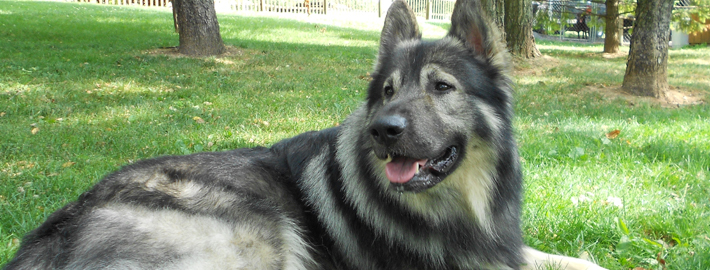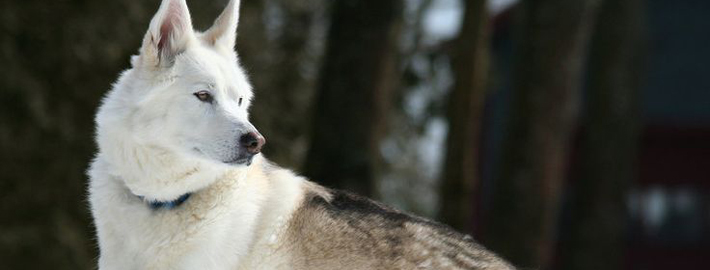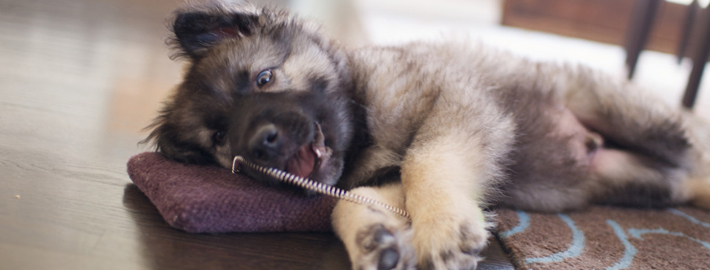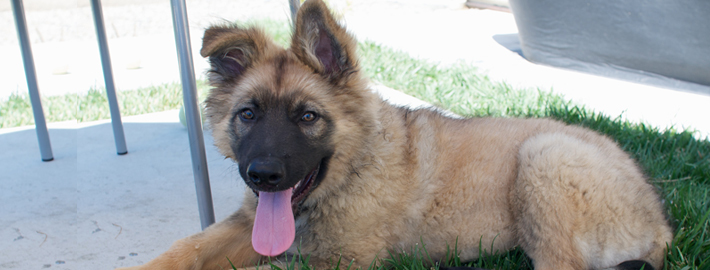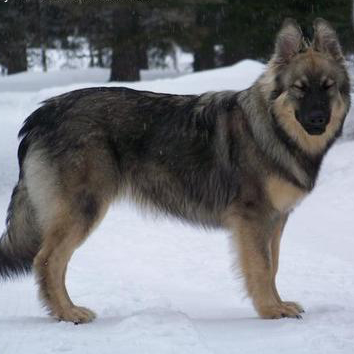What makes the American Alsatian Unique?
Formerly known as the American Shepalute, this large modern breed was specially developed to serve as companions to their human owners.
Page Contents
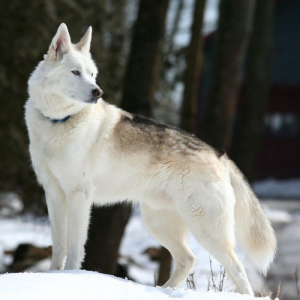
Is the American Alsatian Right For You?
The American Alsatian is an excellent breed for families. Other pets and small children pose no safety concerns around these dogs. Although they are large in stature, these animals were bred to be close to their family so they may be best as indoor pets. These reasonably intelligent dogs learn quickly and respond well to commands as well as gentle correction. This quiet breed of dog is not prone to whining, digging, and barking as is the case with many breeds as long as they receive enough exercise. Loud sounds do not typically upset Alsatians.
Although they do not have the high energy levels that many large breeds possess, American Alsatians will still require a short daily walk to keep them at their best. When American Alsatians are in the process of undergoing their seasonal shedding, they may need to be combed several times per week. Brushing a dog’s teeth on a regular basis is additionally useful in helping prevent both bad breath and the onset of periodontal disease.
In 5 Words
- Extremely loyal
- Watchful
- Extremely calm
- Quiet
- Intelligent
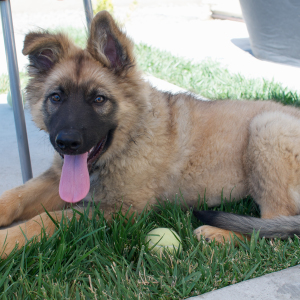
Characteristics
Learn About the American Alsatian
Description
General Description
In keeping with Ms. Schwartz’s original plan, these dogs look very similar to the slow moving dire wolves that existed during the Pleistocene age. American Alsatians have almond shaped eyes ranging in color from pale brown to yellow. They have a wolfishly intelligent expression. Members of this breed also have erect ears and black tipped tails. American Alsatians are somewhat longer than they are tall. A dark colored strong muzzle and broad head are other features of this breed. These dogs further have wide hips, deep chests, and rounded legs.
Size
On average, males of this breed will weigh between 79 and 120 pounds. Females tend to weigh somewhat less at 75 to 100 pounds. The males are also slightly taller at 25 to 28 inches high, with the female Alsatians coming in at 24 to 27 inches tall.
Coat
These dogs have a dense double coat of moderate length that sheds heavily at certain times of the year. Their coarse outer coat is usually has dark tips but is otherwise light in hue. Typical colorations include cream, black sable, gold, and silver. Silver sable markings are preferred and, as a result, they are the most common. White and black markings are considered rare in this breed. Most puppies start off darkly colored but turn cream colored as they age. Once they reach the age of several months, American Alsatians will start growing a coarser coat. Prospective owners should also note that the standards for this breed state that a dog’s color should be secondary to its personality and conformation to other specifications.
Short History of the American Alsatian
In 1987, Lois Denny Schwartz began creating a large breed of dog that did not require as much exercise as other, similar varieties did. These animals were to resemble North American dire wolves in appearance, though that particular animal had long since gone out of existence. A year after the breeding program started, the National American Alsatian Registry was created to keep up with the resulting dogs. This new type of dog came about due to the selective cross breeding of many different dog varieties including Great Pyrenees, Alaskan Malamutes, and German Shepherds among others. To keep these dogs even in temperament any breeds with recent wolf ancestry cannot be crossbred into their lines. American Alsatians are not yet recognized by any major kennel clubs.
Temperament
Bred to be particularly close to their human owners, the American Alsatian is an excellent breed for families. Other pets and small children pose no safety concerns around these dogs. Although they are large in stature, these animals were bred to be close to their family so they may be best as indoor pets. These reasonably intelligent dogs learn quickly and respond well to commands as well as gentle correction. This quiet breed of dog is not prone to whining, digging, and barking as is the case with many breeds as long as they receive enough exercise. Loud sounds do not typically upset Alsatians. Members of this breed also exhibit relatively calm behavior but they are not very playful. Although American Alsatians will keep their distance from strangers, this breed is neither shy nor aggressive. Of course, it is always important to make sure that puppies are well socialized to prevent any problems from arising later in the dog’s life.
Caring for Your American Alsatian
General Health
Born in litters of between 5 and 12 pups, the American Alsatian can live about 13 years in good health. A breeding program has been developed to further expand the life of these dogs from their current average to around 20 years. Therefore, even dogs with the smallest of health problems are not generally bred. This has served to reduce the overall amount of illness found in American Alsatians. This breed has had no reported incidents of ear or eye problems over the course of their history. These dogs also seem to be generally free of hip dysplasia. The last documented case of panosteitis was recorded in 2004.
At the present moment, seizures seem to be the most common health concern in American Alsatians and this condition occurs in 1 dog out of every 200. Following a routine rabies shot in 2009, a young puppy was reported to have suffered from seizures that apparently cleared up within the week. Members of this breed do occasionally suffer from arthritis and elbow dysplasia.
Care
Daily
Although they do not have the high energy levels that many large breeds possess, American Alsatians will still require a short daily walk to keep them at their best.
Weekly
When American Alsatians are in the process of undergoing their seasonal shedding, they may need to be combed several times per week. Brushing a dog’s teeth on a regular basis is additionally useful in helping prevent both bad breath and the onset of periodontal disease.
Monthly
It is also a good idea to provide pets with monthly flea, tick, and heartworm prevention medication.
Grooming & Bathing
Some dogs of this breed shed quite heavily. Keeping up with their grooming requirements at such times and keeping one’s household from becoming overwhelmed with fur can be a large responsibility for Alsatian owners. It is likewise important for owners to make sure their dogs have their toenails trimmed and their ears cleaned on a regular basis. Prospective owners should also note that, due to their thick coats, these dogs probably will do best in cooler environments. However, the Alsatians can be kept clipped in warmer climates to prevent them from getting overheated.
Exercise & Training
Members of this breed are known for their quiet personalities as well as their desire to please and be around their human family. Separation anxiety can sometimes occur in Alsatians that are left too much on their own. However, this breed is has been developed for both high intelligence and trainability. American Alsatians in particular are known to make good therapy dogs.

